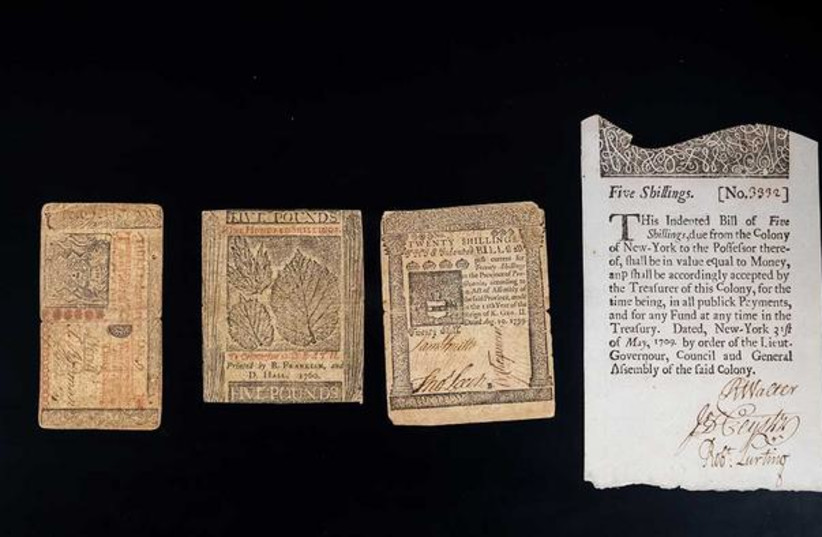Benjamin Franklin – one of the founding fathers of the US, a writer, diplomat, inventor, statesman and political philosopher – was apprenticed to his elder brother James as a printer because his parents couldn’t afford to send him to school after age 10. He wrote and printed the witty and wise Poor Richard's Almanack and the Philadelphia Gazette.
Considered the most accomplished printer in Colonial America, Franklin also made money – literally – by printing bank notes. During his career, produced almost 2.5 million bills of money for the American Colonies using what the researchers have identified as highly original techniques. This has just been reported in a study published in the Proceedings of the National Academy of Sciences under the title “Multiscale analysis of Benjamin Franklin’s innovations in American paper money.”
The research team, led by physics and astronomy Prof. Khachatur Manukyan of the University of Notre Dame in Indiana, has spent the past seven years analyzing a trove of nearly 600 notes from the Colonial period. They are part of a large collection developed by the Hesburgh Libraries’ Rare Books and Special Collections. The Colonial notes span an 80-year period and include notes printed by Franklin’s network of printing shops and other printers, as well as a series of counterfeit notes.
Counterfeit money stood in the way of the Colonies' financial and political independence
Manukyan explained that the effort to print money for the fledgling Colonial monetary system was important to Franklin not just as a printer but as a statesman as well.
“Ben Franklin saw that the Colonies’ financial independence was necessary for their political independence. Most of the silver and gold coins brought to the British American colonies were rapidly drained away to pay for manufactured goods imported from abroad, leaving the Colonies without sufficient monetary supply to expand their economy,” Manukyan added.

One major problem stood in the way of efforts to print paper money was counterfeiting. When Franklin opened his printing house in 1728, paper money was a relatively new concept. Unlike gold and silver, paper money’s lack of intrinsic value meant it was constantly at risk of depreciating. There were no standardized bills in the Colonial period, giving counterfeiters the ability to pass off fake bills as real ones. In response, Franklin worked to embed a suite of security features that made his bills distinctive.
Franklin's use of unique pigments allowed researchers to understand his methods in detecting counterfeits
“To maintain the notes’ dependability, Franklin had to stay a step ahead of counterfeiters,” said Manukyan. “But the ledger where we know he recorded these printing decisions and methods was been lost to history. Using the techniques of physics, we have been able to restore, in part, some of what that record would have shown.”
Manukyan and his team employed cutting-edge spectroscopic and imaging instruments housed in Notre Dame’s Nuclear Science Lab and four other core facilities that make it possible for them to get a closer look than ever at the inks, paper and fibers that made Franklin’s bills distinctive and hard to replicate.
One of the most distinctive features they found was in Franklin’s pigments. The team determined the chemical elements used for each item in the collection of Colonial notes; they discovered that the counterfeits have distinctive high quantities of calcium and phosphorus, but these elements are only in traces in the genuine bills.
Franklin used special black dye, special paper, and muscovite
Their analyses revealed that although Franklin used and sold “lamp black,” a pigment created by burning vegetable oils, for most printing, Franklin’s printed currency used a special black dye made from graphite found in rock. This pigment is also different from the “bone black” made from burned bone, which was favored both by counterfeiters and by those outside Franklin’s network of printing houses.
Another of Franklin’s innovations was in the paper itself – including tiny fibers in paper pulp that are visible as pigmented squiggles within paper money. These have often been credited to paper manufacturer Zenas Marshall Crane who introduced this practice in 1844, but Manukyan and his team found evidence that Franklin was including colored silks in his paper much earlier.
The team also discovered that notes printed by Franklin’s network have a distinctive look due to the addition of a translucent material they identified as muscovite, which Franklin began adding to his papers – and the size of the crystals in his paper increased over time. The team speculates that Franklin initially began adding muscovite to make the printed notes more durable but continued to add it when it proved to be a helpful deterrent to counterfeiters.
